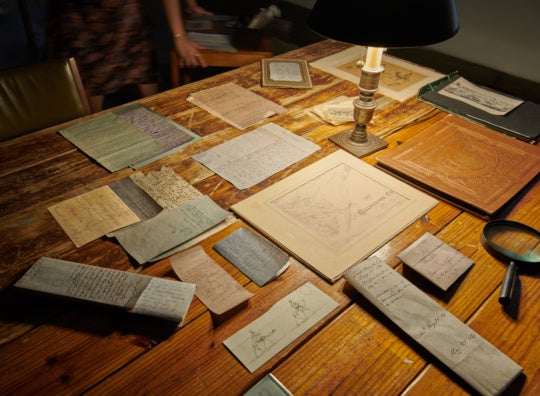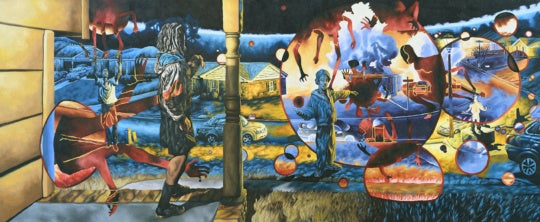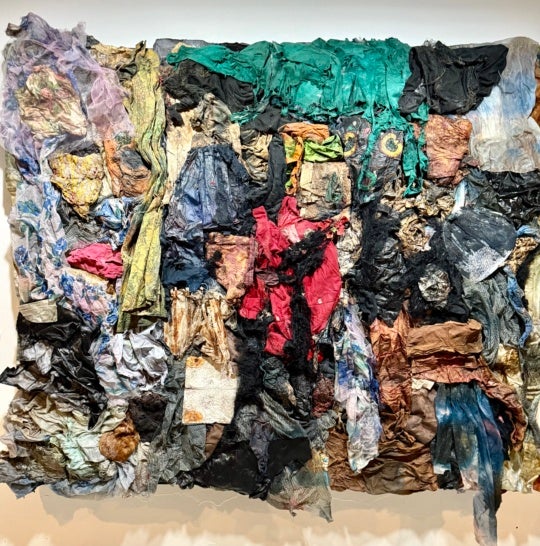
The idea for BURNAWAY originated from a front-porch conversation about the need for more dialogue about local art. Today’s guest for Our Front Porch is Sarah Stein who wrote a letter to the editor responding to recent coverage of FLUX Night. The opinions that follow are those of the author and do not represent any organization.
Dear BURNAWAY,
You’ll have to forgive me for beginning the only letter I’ve ever written you with a complaint. But I must express my disappointment with this year’s incarnation of FLUX Night. I walked away from Castleberry Hill on October 6 with a rather stale taste in my mouth. So I have turned to you, BURNAWAY, “destination for engaged dialogue about the arts,” to share my thoughts.
First, let me qualify my plaintive posture: I love Flux Projects, and particularly their FLUX Night. I didn’t attend FLUX with the idea of reviewing it. I went to be immersed in the spatial and temporal whimsy that I had experienced for two prior years. But when I arrived, FLUX had changed—it had become more popular, more superficial, and far more interested in going to a certain kind of party. In short, FLUX spurned me like a former best friend as she ascends into the popular crowd.
[Editor’s note: For some background on previous years, check BURNAWAY’s official 2011 review and 2010 review.]
With only 14 commissioned pieces, this year there just wasn’t enough FLUX to go around. In 2011 FLUX presented 34 projects; the year before that, there were 27. While the funding for each individual piece may have been greater this year, the tradeoff collapsed under the weight of the crowd. People roamed the streets searching for art instead of encountering it. On numerous occasions, I witnessed folks unapologetically elbowing their way across one another to get a glimpse of various projects. Many of the performances were located seemingly without consideration for crowd density or visibility, limiting access through saturation alone.
An hour or so in, having grown frustrated with the experience, I took a time-out and sought solace in a beer. At this point I noticed that FLUX had dramatically increased food and beverage vendors. I have nothing against festival food and beers, per se, but I lament that, at an event dedicated to “art and experimentation,” it took me far less effort to get a beer than to locate and interact with the art.
It’s possible that, by featuring local shops and vendors, FLUX intended to integrate the surrounding community. I applaud the effort, but with a caveat: the manner of integration should serve the underlying mission of FLUX. In my humble opinion, FLUX is not an Atlanta street festival that happens to be at night. If it were, we would call it “Castleberry Hill Night Under the Stars.” FLUX is also not about promoting Castleberry Hill shops and galleries. That’s the mission of the neighborhood’s art stroll. Rather, it has been my understanding that FLUX exists first to showcase the possibilities created when art is injected into the time and space of an urban landscape that is quintessentially situated in Atlanta. There can be food and beer and open shops, but those elements of consumption should either be the art itself or should remain at the margins of the experience.
In contrast to this year, past FLUX projects—such as Circle Studios’s Under the Bridge or Micah and Whitney Stansell’s Between You and Me—seamlessly incorporated Castleberry Hill’s architecture and terrain into an encounter with art. This year, most of the projects seemed to be scattered about the arts district with little attention paid to their locations or to the way someone might walk between and among them.
For example, the flatiron-shaped building on Walker street boasts some fabulous wrap-around window frontage, but the piece that it housed, Ceiling of Blackbirds, faced the opposite direction, obscuring the project from the street, where it could have been visible from a good distance. It wasn’t a tragic error, but seemed to be the kind of missed opportunity that implies a curatorial inattention to detail.
Similarly, Eli Keszler’s piano strings installation, which made fabulous use of the resonant capacities of a parking garage, became a crowd-flow nightmare. The courtyard stairwell was roped off (to protect the piano strings?), so the heavy traffic had to awkwardly squeeze through a bottleneck pathway. To get out of the courtyard, you had to exit through the back door of a gallery or turn around and swim upstream through the crowd. While this observation makes no claims against the merits of Keszler’s work, Keszler probably did not intend for his piece to become a meditation on agoraphobia.
I also want to say a word about something that lies near and dear to my heart and I hope yours as well, BURNAWAY. Of the 14 projects commissioned for FLUX Night this year, nearly half of them hailed from artists who claim no central affiliation with Atlanta. In comparison with previous years, this ratio suggests an abandonment of the assertion that Atlanta is home to cutting edge art.
This isn’t to say that FLUX didn’t feature cutting-edge art by Atlanta artists, however. Nicole Livieratos’s Turn the Page presented an evocative and energetic meditation on the “propensity to persist in repeating patterns of behavior regarding energy consumption.” I very much enjoyed the parts of it that I could catch through the crowd. Dorothy O’Connor’s Ceiling of Blackbirds, a tableau vivant where two women slowly created a ceiling of paper blackbirds in a meticulously vintage bedroom scene, marked another excellent work by an Atlanta artist. The details were breathtaking—I only wish it were visible from the street. At the end of the night, I ducked in to catch the last ten minutes of Ben Rollins’s This Sacred Life. It was an utterly amplifying experience where participating audience members sat surrounded by Atlanta Sacred Harp Singers who performed shape-note music against a wrap-around backdrop of archival video clips. It was at once soulful and chaotic.
If I had spent the entire night in the center of that circle enjoying This Sacred Life, I might not be writing this letter today. Although, likely I would be, because part of the joy of FLUX is the flow between the art, the excitement of what may come next—and that joy was markedly less present at FLUX this year.
I imagine it’s difficult for organizers to continue to re-incarnate the FLUX experience on an annual basis. Perhaps some will argue that, in selecting these projects, FLUX chose to showcase some of Atlanta’s most promising work next to high-profile art from elsewhere. Perhaps some will even claim that this strategy wins the Atlanta art scene greater claim to cosmopolitan status. These may be the new goals for FLUX night, and there may be much to gain from their implementation. But in response to such claims, I can merely choke back a few tears as I mourn for my lost friend, the old FLUX, and go search for someone else to play whimsical games with.
After two years of successful, interactive art extravaganzas, the high turnout presented FLUX with an exciting opportunity: expose throngs of newcomers to contemporary art in a unique, intentional, urban landscape of experience. Unfortunately, FLUX ducked the challenge, choosing instead to throw a block party flecked with disjointed curiosities.
I write this letter to share my sadness, which seems a nasty gift to bear. I do so with the hope that you, BURNAWAY, can help me engage in the dialogue about what FLUX has created for Atlanta, what it has left behind, and what new possibilities might take root in the gaps.
Warmly,
Sarah Stein
Sarah Stein is a JD/PhD student in her fifth consecutive year of graduate education. To pay for her affluent lifestyle, she sells t-shirts on cafepress.com that read “tanta escuela me apendeja.”
Disclosure: Louis Corrigan, the founder of Flux Projects, has donated significant funds to this publication. In pursuit of featuring work that significantly contributes to cultural discourse, as well as our commitment to transparency, our policy is to disclose instead of exclude.
Please feel free to participate in the open comments underneath this article, or share it elsewhere and discuss informally with your friends. Talking in person counts! Our Front Porch is a series inviting guest contributors to share thoughts on local art for open discussion with you, our readers.




